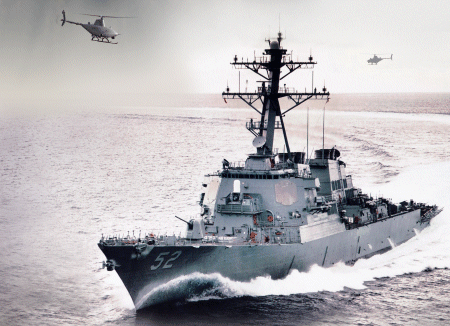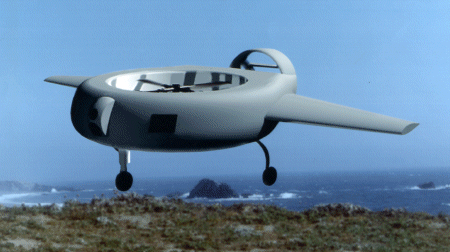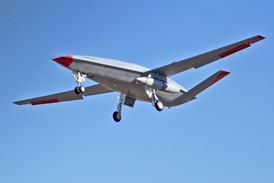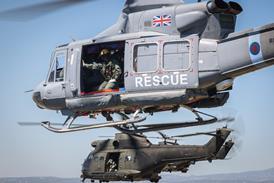PETER LA FRANCHI / CANBERRA
VTOL UAV concepts abound, but market penetration remains a slow process

Early in March, a group of Bell Helicopter Textron officials briefed the bi-annual Australian Aerospace Congress in Canberra on the future of its TR-911 Eagle Eye tiltrotor unmanned air vehicle programme. Coming just over a year after the company had lost the US Navy's vertical take-off and landing tactical UAV (VTUAV) competition to Northrop Grumman's Firescout, the briefing offered a surprise market forecast. A mix of naval and land-based requirements, Bell argued, could generate sales of 80 Eagle Eye UAV systems a year between 2004 and 2010.
The value of those sales, the company suggested, could total $100-120 million per year. But the company also acknowledged that its forecast was not actually based on firm trend data. It was difficult, the company said, "to generate hard data on the size of our market for the tiltrotor UAV. Our model has not been widely demonstrated to potential customers except the USN. Little has been written about it. Until we show what the tiltrotor UAV can do for the customer, we can't really ask for orders or seek strong expressions of interest."
The bottom line, the company revealed, is that its forecast was based on "knowledge of the helicopter industry and of defence", and that knowledge suggests "a large market out there".
Bell is not alone in combining an optimistic outlook with a willingness to attach numbers to a "gut feeling". Its assessment reflects a general view throughout much of the UAV industry that (theoretically) there is a large market for rotary wing systems. The problem - Bell assessments included - is that the theory still largely awaits translation into firm orders.
Even the most obvious naval buyers have proven to be more accepting of fixed wing solutions despite a variety of air vehicles and control systems being available for more than three decades. Not surprisingly, last February's selection of the Firescout by the USN is seen by many analysts as marking a long-awaited break-through, even if that programme still has many hurdles to overcome before full-scale production contracts are awarded some time in 2004.
Shipborne UAVs
The military utility offered to naval forces by shipborne UAVs of all types has long been demonstrated by fixed-wing air vehicles. In supporting surveillance and sea control tasks, a UAV can enable the direct extension of a warship's sensor picture to cover vastly larger areas of interest and provide earlier situational awareness of what is developing "over the horizon". Depending on the UAV's size, that benefit is potentially available even to the smallest warships, not just those which support aircraft.
The predominance of fixed-wing UAVs on warships generally reflects their relative maturity over the rotary wing alternatives, particularly in terms of endurance capability. The problem of air vehicle recovery, however, remains the key driver turning navys away from fixed-wing systems towards VTOL solutions. The USN, for example, has operated its Pioneer UAV from large warships for 14 years, relying on its controlled crash into large nets for its recovery. The former US TRW/IAI Hunter Joint Tactical UAV programme proposed a combination of cross-deck cables and nets to recover the naval variant, a solution which would have limited the system to operations from amphibious assault ships.
According to Quinton Long, a Texas-based senior aerospace analyst for the Frost & Sullivan forecasting group, "as the footprint of aircraft carriers and other ships get smaller", the USN is "looking for ways to keep that airborne presence but have a smaller footprint to launch it".
Before selecting the Firescout, the USN had explored rotary-wing UAV operations in anti-submarine warfare roles. Between 1960 and 1969 the navy accepted around 800 QH-50 Dash air vehicles, of which 400 were lost during operations. The air vehicle carried two Mk44 torpedoes, but had the unfortunate tendency to become seriously unstable after firing them. The air vehicle itself, however, has gone on to form the basis of the Seamos rotary wing UAV being developed by EADS for the German navy and forming the main technology focus for the NATO Project Group 35 naval UAV demonstration programme.

The USN also undertook an extended evaluation of rotary wing technology in 1998, including flight trials of the Bell Eagle Eye and Bombardier CL-327. Based on the outcome of that programme, many analysts believed the Eagle Eye would win the USN's VTUAV competition. The subsequent choice of the Firescout over the Eagle Eye is generally seen to reflect a major price differential between the two bids, and the need for tiltrotor technology to mature further. This point was dramatically brought home by last year's crashes of the Bell-Boeing V-22 Osprey being built for the US Marine Corps.
According to Long, at least part of the reason for the extended gap between the QH-50 and the Firescout has been that fixed wing systems were "things that people know best. They have a glide ratio better than a rock and people tend to think that they are a little bit safer. We have done a lot of research in those areas. Helicopters themselves are not the most stable of systems-even with a pilot on board, they are pretty tricky to fly. You have got to counter torque and those sorts of issues."
VTOL UAV development has been littered with more than a frequent spattering of failures. Bombardier, for example, has pioneered co-axial rotor VTOL UAVs with its CL-327 design flying for close to a decade. In 1995, without firm orders, the company optimistically put the CL-327 into production. But six years later, it still awaits buyers despite having participated in extensive international demonstration programmes and trials.
History of losses
The CL-327 has also racked up a history of losses. In 1998, while participating in the USN's VTOL demonstration programme at Yuma proving grounds in Arizona, a CL-327 lost its fuel tank in flight and crashed. Bombardier said that the accident was caused by structural failure which would be rectified through design changes. In August 1998, two months after the crash, a three-month-long Australian Army demonstration programme was terminated in mid-course after one of two leasedCL-327s also crashed, destroying the only available sensor payload.

Sikorsky has experimented with ducted fan designs since the early 1990s, eventually securing a US Marine Corps contract to demonstrate an evolved form of its Cypher UAV under its Dragon Warrior programme. Last December, however, the USMC decided to shelve that demonstration due to slower than expected progress in development of the Cypher II air vehicle, handing it over to the US Army to troubleshoot. Sikorsky acknowledged major mechanical problems associated with the development of a two-engine drive-train at the time, but has since developed a solution.
The EADS Seamos has had similar difficulties since development first commenced in the late 1980s to support the German navy, leading to the replacement of its engine and navigation systems. EADS' sole demonstrator air vehicle was severely damaged in a crash during tethered flight in mid-1999, but this was caused by the failure of part of the anchoring system and not air vehicle problems. EADS is continuing development with a programme of sea trials which commence next year as part of the NATO PG35 programme.
Even the Firescout has had problems. The first test vehicle crashed in November despite extensive flight testing of manned variants over two years, and a relatively low-tech development based on a proven commercial manned helicopter design.
Northrop Grumman acknowledges that the Firescout VTUAV programme carries a weight of expectations given the history of VTOL UAVs. Douglas Fronius, director of engineering, logistics and technology with Northrop Grumman's Ryan Aeronautical Center and former Firescout programme director, says that weight "is a real burden but it is not unfair. It is just natural. Global Hawk carries that burden for high altitude endurance."
Long time to fruition
But VTOL UAVs, he argues, do not necessarily show a different rate of progress than their fixed-wing equivalents. "Almost the same question could be asked of UAVs in general. Why, if UAVs have shown so much potential, has it taken so long for any one to reach fruition? I don't particularly consider the fact that Firescout is vertical take-off to be a significant issue.
"We know how to do vertical take-off. We have been building helicopters since the 1940s and they were fairly well perfected in the 1950s. There is no mystery to vertical flight. We have also been making fixed wing aircraft and long endurance high altitude aircraft for decades. There is no mystery, from an aeroplane point of view, to Global Hawk. What is new, what makes a Global Hawk or a VTUAV or some other UAV suddenly have potential for real application is the integration of a number of technologies or capabilities into a package that works."
The Firescout, Fronius says, is not a case of "trying to invent a brand new technology for vertical take-off". Instead, he says, the development needs to be understood as "trying to make vertical take-off technology work as a UAV. The basic airframe that we are flying was designed in the 1950s. It has gone through a whole series of upgrades, propulsion enhancements, drive train enhancements, aerodynamic enhancements, rotor blades, but basically it was designed in the late 1950s for army training. That is good because now we don't have to worry either about that part of it, or about putting all of our effort into developing this new technology for vertical take-off which is high risk. If the world wants UAVs to be developed in very short time, and at lower cost than manned aircraft, you had better not make that technology higher than manned aircraft."
This approach, Fronius says, is allowing Northrop Grumman to concentrate "on implementing all the UAV kind of things: communications, systems management, operator interaction, human computer interfaces. To make the system practical and effective". That overall system, he argues, provides the framework through which the VTUAV will fail or succeed.
But once the system is proven, then the scope for new air vehicles, initially based on the Firescout but also including other design approaches, begins to open up. "We have to look at the complete system architecture. Once that is established, then we can start to design a different version of a vertical take-off UAV which uses all of that established infrastructure. Maybe one day a Firescout will land on the deck, and the next day a 'Superscout' lands.
Same infrastructure
"They may be completely different looking things but they use all the same infrastructure. Right now UAVs tend to be unique, specific and customised. We need to get to the point where they are generic and standardised in how they operate to allow the systems to be effective," he says.
While new VTOL UAV configurations are likely, Fronius says, the overall market segment is likely to closely reflect the current breakdown of the manned aircraft market between fixed and rotary wing platforms. "From a dollar value, the fixed wings should maintain similar ratios to vertical take-off as they do in manned systems."
Fronius also argues that VTOL UAVs are likely to fill a variety of "specialised niches where there are special performance requirements that might be surprisingly filled by a vertical take off UAV, but I don't think they will dominate [against fixed wing UAVs in market share]."
According to Bell's Long, the US Defense Advanced Research Projects Agency's organic air vehicle UAV programme is a clear example of where that niche approach may pay off. The concept calls for a small VTOL UAV carried on the hull of armoured fighting vehicles or other ground transports and used to provide enhanced situational awareness in an immediate battlefield environment, particularly during urban operations. n
Source: Flight International
















